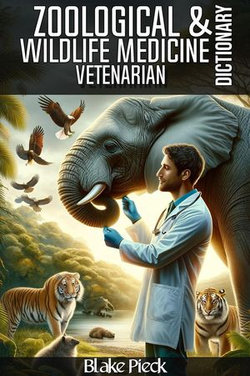Zoological and wildlife medicine focuses on the health, conservation, and treatment of wild animals, exotic species, and those living in zoos, wildlife reserves, and natural habitats. This field of veterinary medicine integrates disease prevention, rehabilitation, research, and conservation efforts to protect individual animals and entire species from a variety of threats, including habitat destruction, climate change, poaching, and disease. Wildlife veterinarians work in diverse environments, including zoos, sanctuaries, research institutions, and field conservation programs, ensuring the well-being of animals both in captivity and in the wild. This dictionary offers valuable insights into the practices and challenges faced by veterinary professionals dedicated to the care and conservation of wildlife and exotic animals.
Conservation Medicine – Conservation medicine focuses on the health and well-being of wildlife populations and the ecosystems they inhabit, with a particular emphasis on the interconnections between animal health, environmental health, and human health. This specialty addresses issues such as habitat destruction, disease transmission between wildlife and humans, and the effects of climate change on animal species. Conservation medicine aims to develop strategies that balance the health needs of wildlife with broader environmental conservation goals, often involving collaborations with ecologists, environmental scientists, and policymakers to ensure sustainable ecosystems and biodiversity.
Wildlife Rehabilitation – Wildlife rehabilitation is the process of caring for injured, sick, or orphaned wild animals with the goal of releasing them back into their natural habitats. This practice requires specialized knowledge in animal care, behavior, and species-specific needs, as well as expertise in handling the psychological and physiological challenges of rehabilitation. Veterinarians and rehabilitators assess the animals' health, provide necessary treatments, and ensure they are fit for release, minimizing human dependence while preparing the animals for survival in the wild. This section highlights the importance of wildlife rehabilitation in preserving biodiversity and offering second chances to injured or orphaned animals.
Zoo Animal Care – Zoo animal care involves the management and treatment of animals kept in zoos and zoological institutions. This specialty encompasses veterinary care, enrichment programs, and habitat design to ensure the animals' physical and psychological well-being in captivity. Zoo veterinarians monitor the health of animals, conduct regular check-ups, manage disease outbreaks, and oversee breeding programs to maintain genetic diversity. Additionally, they work on conservation efforts, using zoos as hubs for breeding endangered species, research, and public education. This section explores the unique challenges and responsibilities involved in caring for animals in zoological settings, as well as the role of zoos in global conservation initiatives.



Share This eBook: